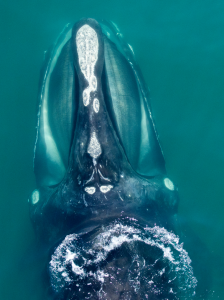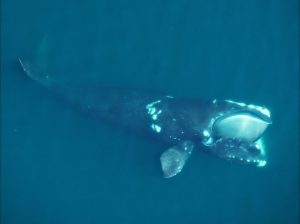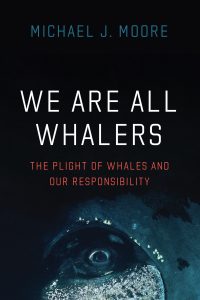Read an Excerpt from “We Are All Whalers” by Michael J. Moore
The North Atlantic right whale is a species so endangered that there are likely more researchers in the world studying them than there are individual whales in the sea. Killed by entanglement in fishing lines and collision with boats moving along global shipping routes, their population has declined more than 20 percent since 2017. Their plight, and the plight of many other whale species, is a catastrophe for which we unquestionably all share accountability. And yet, as marine scientist and veterinarian Michael J. Moore argues in his thought-provoking, moving debut, it is a problem we also all have the power to solve. Drawing on over forty years of fieldwork with right and other whales as well as independent research alongside commercial whalers, Moore reveals an infuriating, confounding web of poorly enforced conservation laws, profiteering, and accidental bycatch. But there is also hope: in existing technologies—such as acoustic tracking and ropeless fishing gear, even now being put into use—and in a community of researchers and activists working to bring about change. Indeed, Moore now appears in the documentary Last of the Right Whales, recently premiered at the Calgary International Film Festival and soon to be in theaters, which honors that community and the plight of the whales they are fighting to protect.
More than this, Moore also finds hope in all of us, as compassionate beings and informed consumers, and in a changing tide of social, economic, and political forces uniting around a central idea: We may all be whalers—but we do not have to be.
Read on for an excerpt from the preface of We Are All Whalers: The Plight of Whales and Our Responsibility
Recently, I spent an early April day in the southwestern corner of Cape Cod Bay, in eastern Massachusetts, in the United States, with a friend. He had been at sea his entire working life, but had never knowingly been close to a right whale. His day job was master of an oil tanker on the Valdez, Alaska, to San Francisco, California, run, where he might have been close to a North Pacific right whale (Eubalaena japonica). He was vastly overqualified to skipper our boat, which he did while I piloted a small drone to measure the lengths and widths of the many feeding North Atlantic right whales (Eubalaena glacialis) we had found in a small area. There was no wind that day. The sea was like a millpond. It was crisp, cold, sunny, and quiet. We shut down the motor, drifted, watched, and listened. As each animal surfaced, exhaled, and immediately inhaled, we listened to the unique cadence of their breaths, and we watched their steady progress through the water with their mouths wide open, filtering the clouds of food close to the surface. Periodically, they slowly closed in on the boat, and we could see into their open mouths, with small eddies of water peeling away from their lips. Much larger eddies formed in their wakes as their powerful tails and bodies pushed them along. They made tight turns, using their huge flippers and tails as rudders, to keep themselves within the food patches. This went on all day. As the sun started to sink behind the cliffs on the nearby western shore of Cape Cod Bay, their creamy white upper jaws, just visible above the surface, turned to a vibrant golden hue. It was a peaceful, majestic, timeless sight, and a huge privilege to be permitted to study these animals. At the end of the day, my friend said that he understood why I care so passionately for them. Words often fail when I try to express the awe and wonder that these animals elicit; this book is my attempt to do them justice, and keep them out of jeopardy.

My hope is to convince you that the welfare of individual North Atlantic right whales, and the very survival of the species, is in our hands. Few humans eat whale meat anymore, but fishing techniques unintentionally harm and kill whales. Even vegetarians contribute to the problem, as we all benefit from global shipping of consumer goods and fuel, which, in its current iteration, leads to fatal collisions with whales. Entanglement in fishing gear can sentence these animals to months of pain and a slow death. Both the US and Canadian governments are stuck in a major conflict of interest: protecting the livelihoods and businesses of the marine transportation and fishing industries, but at the same time recognizing the value of biodiversity, animal welfare, and avoidance of species extinction. Recently, the latter values have taken a back seat. It doesn’t have to be this way. We have the technology and the collaborations that are necessary to change the right whales’ future, but consumers have to use their wallets to make it happen. Hopefully, politicians still listen to their electorate.
***
This is a story that began for me as a child in England, raised by caring people, learning from our challenges and traumas, as all families do. I was taught how to survive on the water, maintain boats, and explore. I trained as a veterinarian, but I also had the chance to pursue my own curiosity. I was shown the enormous wealth of a productive marine ecosystem, off eastern Newfoundland, but also the harsh reality of the trauma whales face when in conflict with humans harvesting a mutual food resource. An opportunity arose to document the remarkable efficacy of direct harvest of large whales in Iceland—a reality whose relevance to my later work took decades to come in to focus.
I then describe a small window I was given into the millennia of native subsistence harvest of the bowhead whale in the Arctic. The native hunters had truly conserved the whales’ habitat, and hence the whales, in spite of the best efforts of both nineteenth-century commercial whalers from New England to wipe out the species and recent oil exploration to degrade its habitat. The Alaskan Iñupiaq sense of the long view, and respect for the whales as a part of their culture, made me hope that modern marine industries could also sustainably coexist with right whales in their habitat.

As I slowly grew to understand the impacts of industrial fishing practices and vessel collisions on large whales, I fell into the role of a large whale trauma diagnostician. Along with a few dear colleagues, I provided a scorecard for government efforts aimed at reducing such impacts. We worked with all of the affected whale species in New England: humpback, blue, fin, sperm, minke, and right, in addition to smaller whales, dolphins, and seals. But it was the right whales that were the most prominent and imperiled in their plight. But what is good for right whales will be good for the others, too. We tried to intervene with some sick whales, to reduce their suffering, but realized that prevention of the trauma was the only lasting solution. So now I work with scientists, engineers, fishermen, lawyers, government managers, and nongovernmental organizations to promote a safe, profitable, sustainable seafood harvest that will allow the North Atlantic right whale to turn another corner and prosper once more. Despite all I’ve seen, I have hope. I believe we can reverse the trend such that a thousand years hence, right whales will be as numerous as before we started killing them, whether with intent or by accident.

Michael J. Moore is a veterinary scientist at the Woods Hole Oceanographic Institution. He lives in Marion, MA. For more information on Moore’s book and research, please visit his webpage at the Woods Hole Oceanographic Institution.
We Are All Whalers is available now! Find it on our website, online at any major booksellers, or at your local bookstore.
